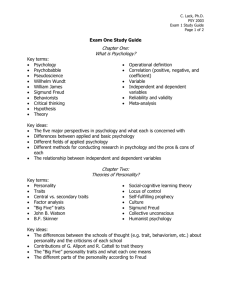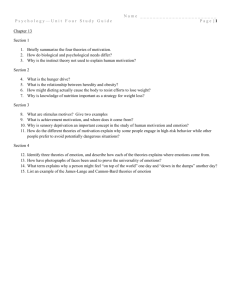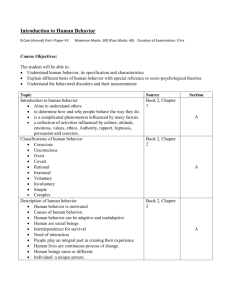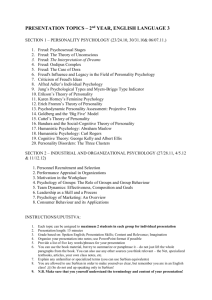personality development - Society for the Teaching of Psychology
advertisement
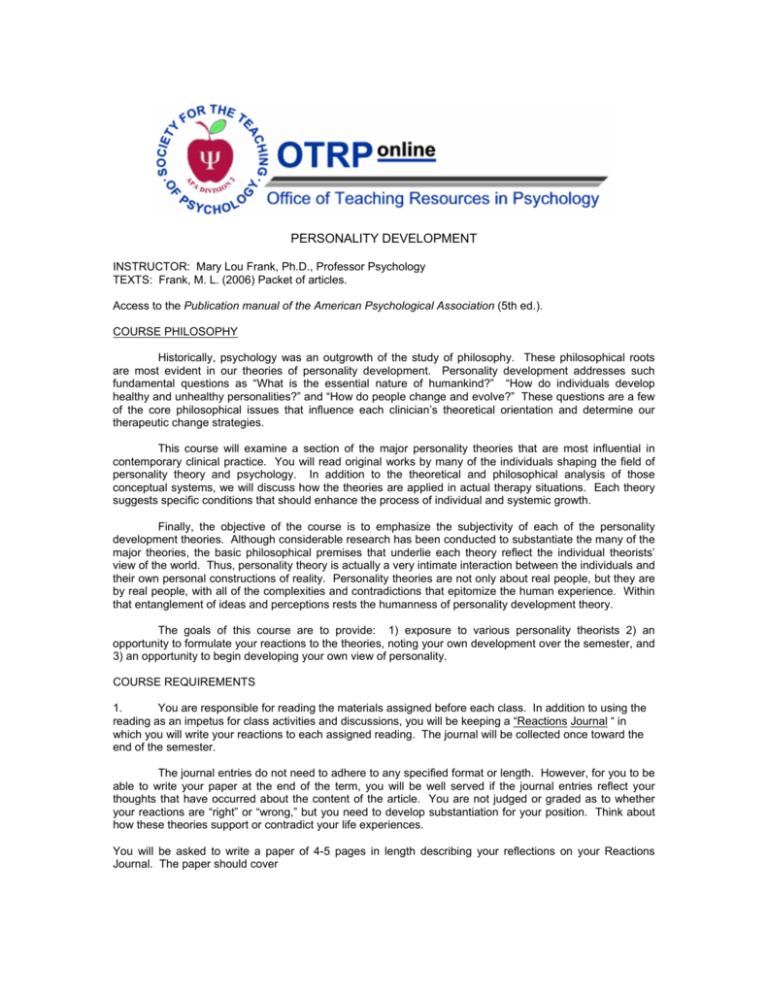
PERSONALITY DEVELOPMENT INSTRUCTOR: Mary Lou Frank, Ph.D., Professor Psychology TEXTS: Frank, M. L. (2006) Packet of articles. Access to the Publication manual of the American Psychological Association (5th ed.). COURSE PHILOSOPHY Historically, psychology was an outgrowth of the study of philosophy. These philosophical roots are most evident in our theories of personality development. Personality development addresses such fundamental questions as “What is the essential nature of humankind?” “How do individuals develop healthy and unhealthy personalities?” and “How do people change and evolve?” These questions are a few of the core philosophical issues that influence each clinician’s theoretical orientation and determine our therapeutic change strategies. This course will examine a section of the major personality theories that are most influential in contemporary clinical practice. You will read original works by many of the individuals shaping the field of personality theory and psychology. In addition to the theoretical and philosophical analysis of those conceptual systems, we will discuss how the theories are applied in actual therapy situations. Each theory suggests specific conditions that should enhance the process of individual and systemic growth. Finally, the objective of the course is to emphasize the subjectivity of each of the personality development theories. Although considerable research has been conducted to substantiate the many of the major theories, the basic philosophical premises that underlie each theory reflect the individual theorists’ view of the world. Thus, personality theory is actually a very intimate interaction between the individuals and their own personal constructions of reality. Personality theories are not only about real people, but they are by real people, with all of the complexities and contradictions that epitomize the human experience. Within that entanglement of ideas and perceptions rests the humanness of personality development theory. The goals of this course are to provide: 1) exposure to various personality theorists 2) an opportunity to formulate your reactions to the theories, noting your own development over the semester, and 3) an opportunity to begin developing your own view of personality. COURSE REQUIREMENTS 1. You are responsible for reading the materials assigned before each class. In addition to using the reading as an impetus for class activities and discussions, you will be keeping a “Reactions Journal “ in which you will write your reactions to each assigned reading. The journal will be collected once toward the end of the semester. The journal entries do not need to adhere to any specified format or length. However, for you to be able to write your paper at the end of the term, you will be well served if the journal entries reflect your thoughts that have occurred about the content of the article. You are not judged or graded as to whether your reactions are “right” or “wrong,” but you need to develop substantiation for your position. Think about how these theories support or contradict your life experiences. You will be asked to write a paper of 4-5 pages in length describing your reflections on your Reactions Journal. The paper should cover 1) 2) 3) what you perceive your development to have been over the course of the semester, significant articles that changed, modified, or validated your perception of others (and yourself), a set of conclusions you have made about personality because of your exposure to the readings. The Reactions Journal and the 4-5 page paper (word-processed, double-spaced) will be collected. The paper will be graded according to the above criteria and the journal for completeness. Neatness and professional presentation are expected at the graduate level. Forty percent (40%) of your grade is based on the Reactions Journal and paper. 2. There will be one required theoretical paper for the semester. It should be original and thoughtful. Please make certain that you use a word processor. The paper will account for 40% of your grade. The following must be included in your paper. 1) 2) 3) a) b) c) d) e) exploration of one theoretical model, explanation of how the model fits you and your life experience, explanation of how the model addresses: the change process, psychopathology, life situations and issues (give an example of an application), individual development the fate/hope of the human condition. Your theory paper should have at least eight (8) references other than the texts. Use original (first) sources whenever possible. (Use the APA reference manual for format. The paper will not exceed five (5) wordprocessed, double-spaced pages in length. *You may explore two models together, however, eclectic models need to be philosophically and clinically consistent. If you have an alternate project idea, you will need to propose the project to your instructor. 3. Class attendance and participation account for 10% of your grade. This is measured by your willingness to contribute when asked, your consistent interest in class discussion, and your desire to offer constructive comments to classroom discussions. 4. The remaining 10% will be based on your presentation of some of your findings from your theoretical paper one of the last two class sessions. The presentation needs to be innovative, insightful, and interesting. Basically, share your thoughts with the class and have some fun with it! READING ASSIGNMENTS Week 1 Personality theory: An introduction McAdams Week 2 Psychoanalytic theory: Freud revisited Freud (3) Blanck & Blanck Orbach & Eichenbaum Week 3 Developmental theory, in stages Erikson Roberts & DelVecchio Week 4 Jung at heart Jung (2) Bolen (1974) Woodman Hillman Week 5 Beyond the personal Hammer Wilber Rowan Week 6 Systems theory: A network Minuchin Jones & Kinnick Levy McLendon, McLendon, & Petr Week 7 Gender development Hotelling & Forest McNamara & Rickard Bolen (1989) Good, Gilbert & Scher Barrett Castellini, Nelson, Barrett, Nagy, &Quatman Week 8 Understanding each other, understanding ourselves: Theories of diversity Pope-Davis, D. B., Liu, W.M., LedesmaJones, S., & Nevitt, J. Diaz-Guerrero McNair Heinrich, Corbine, & Thomas Poston Week 9 Behavior: A science of reason Watson (2) Watson & Rayner Bandura Datilio & Epstein Week 10 Cognitive theory: Thoughtful work Skinner Weinrach Ellis Black *Theoretical paper due Week 11 Behind the mask: Humanism Rogers (2) Maslow (2) Taylor Dass Week 12 Gestalt: The whole thing Perls Rock & Palmer Bernard Henle Week 13 Finding meaning: Existential dilemmas Bugental (2) Yalom (2) Frankl *Reactions journal and paper due Week 14 An integration Week 15 Give presentations to the class Andrews Viney Wrenn Seligman Duckworth et.al. Guterman Lazarus Kelly Reading List Mary Lou Frank, Ph.D. Andrews, J. (1989). Integrating visions of reality. American Psychologist, 44, 803-817. Bandura, A. (1974). Behavior theory and the models of man. American Psychologist, 29, 859-869. Barrett, S. (2005). Multicultural feminist therapy: Theory in context. Women and Therapy, 29, 27-61. Beck, A. (1983). The development of depression: A cognitive model. In T. Millon (Ed.), Theories of personality (3rd ed., pp. 247-256). NY: Holt, Rinehart, & Winston. Bernard, J. M. (1986). Life Lines—Laura Perls: From Ground to Figure. Journal of Counseling and Development. 64 (6), 367-374. Blanck, G., & Blanck, R. (1979). Psychoanalytic developmental psychology: An overview. In G. Blanck & R. Blanck (Eds.), Ego psychology II (pp. 1-14). New York: Columbia University Press. Bolen, J. (1974). Jung, synchronicity, and the self. In The tao of psychology (pp. 11-24). New York: Harper and Row. Bolen, J. (1989). Fathers and sons. In Gods in every man (pp. 17-39). New York: Harper & Row. Bugental, J. (1978). The prospect of a journey. In Psychotherapy and process (pp. 1-45). MA: Addison Wesley. Castellini, J., Nelson, W., Barrett, J., & Quatman, G. (2005). Male spirituality and the men’s movement. Journal of Psychology and Theology, 33, 41-56. Dass, R. (1985). Suffering. In How can I help (pp. 51-92). New York: Alfred A. Knopf. Dattilio, F. M., & Epstein, N. B. (2003). Cognitive-behavior couple and family therapy. In T. L. Sexton, G. R. Weeks, & M. S. Robbins (Eds.), The family therapy handbook (pp. 147-175). New York: Routledge. Diaz-Guerrero, R. (1984). The psychological study of the Mexican. In J. Martinex & R. Mendoza (Eds.), Chicano psychology (2nd ed., pp. 251-268). Orlando: Academic Press. Duckworth, A.L., Steen, T.A., & Seligman, M.E.P. (2005). Positive psychology in clinical practice. Annual Review of Clinical Psychology, 1, 629-651. Ellis, A. (1998). Addictive behaviors and personality disorders. Social Policy. 29 (2), 25-30. nd Erickson, E. (1983). Eight ages of man. In Childhood and society (2 Norton. ed, pp. 247-274). New York: Frankl, V. (1983). Meaninglessness: A challenge to psychologists. In T. Millon (Ed.), Theories of personality, (3rd ed., pp. 256-263). New York: Holt, Rinehart, & Winston. Freud, S. (1910). The origin and development of psychoanalysis. American Journal of Psychology, 21, 181-218. Freud, S. (1953). A difficulty in the path of psychoanalysis. In J. Strachey (Ed.), The standard edition of the complete psychological works of Sigmund Freud (pp. 137-144). London: Hogarth Press. Freud, S. (1953) Warum Krieg? In J. Strachey (Ed.) The standard edition of the complete psychological works of Sigmund Freud (pp. 137-144). London: Hogarth Press. Good, G., Gilbert, L., & Scher, M. (1990). Gender aware therapy. Journal of Counseling and Development, 68, 376-380. Guterman, J. T. (1996) Doing mental health counseling: A social constructionist revision. Journal of Mental Health Counseling, 18, 228-252. Hammer, M. (1974). The essence of personal and transpersonal psychology. Psychotherapy: Theory, Research, and Practice, 11 (3), 202-210. Heinrich, R., Corbine, J., & Thomas, K. (1990). Counseling Native Americans. Journal of Counseling and Development, 69, 128-133. Henle, M. (1978). Gestalt psychology and gestalt therapy. Journal of the History of the Behavioral Sciences, 14, 23-32. Hillaman, J. (1989). Therapy: Fictions and epiphanies. In A blue fire (pp. 71-94). New York: Harper Perennial. Hotelling, K., & Forest, L. (1985). Gilligan’s theory of sex role development: A perspective for counseling. Journal of Counseling and Development, 64, 183-189. Jones, J., & Kinnick, B. C. (1995). Adult children of alcoholics. Journal of Alcohol and Drug Education, 40 (2), 58-71. Jung, C. (1965). Confrontation with the unconscious. Memories, dreams, and reflections (pp. 170-199). NY: Vintage Books. Jung, C. (1965). Psychiatric activities. Memories, dreams, and reflections (pp114-170). New York: Vintage Books. Kelly, E. W,. Jr. (1997) Relationship-centered counseling: A humanistic model of integration. Journal of Counseling and Development, 75, 337-345. Lazarus, A. (1996). The utility and futility of combing treatments in psychotherapy. Clinical Psychology: Science and Practice, 3, 59-68. Levy, J. (2006). Using a metaperspetive to clarify the structural-narrative debate in family therapy. Family Process, 45, 55-64. Maslow, A. H. (1943), A theory of human motivation. Psychological Review, 50, 370-396. Maslow, A. (1962) Some basic propositions of a growth and self-actualization psychology. In Toward a psychology of being (pp. 189-214). New York: Von Nostrund. URL: http://psychclassics.yorku.ca/Maslow/motivation.htm McAdams, D. P. (1995). What do we know when we know a person? Journal of Personality, 63, 365-396. McLendon, D., McLendon, D., & Petr, C. (2005). Family-directed structural therapy. Journal of Marital and Family Therapy, 31, 327-340. McNamara, K., & Richard, K. (1989). Feminist identity development: Implications for feminist therapy with women. Journal of Counseling and Development, 68, 184-189. McNair, I. D. (1992). African American women in therapy: An Afrocentric and feminist synthesis. Women and Therapy, 12 (1), 5-19. Minuchin, S. (1974). The initial interview. In Families in family therapy (pp. 206-239). Cambridge, MA: Harvard University Press. Orbach, S., & Eichenbaum, L. (1983). Locating feminist psychotherapy: Consciousness-raising groups, object relations theory, and gender identity. In C. Brody (Ed.) Understanding women (pp. 3-25). New York: Basic Books. Perls, F. (1977). Here and now therapy. In H. Chiang & A. Maslow (Eds.), The healthy personality: nd Readings (2 ed., pp. 49-58). New York: Von Nostrund. Pope-Davis, D. B., Liu, W. M., Ledesma-Jones, S., Nevitt, J. (2000). African-American acculturation and Black racial identity: A preliminary investigation. Journal of Multicultural Counseling & Development, 28 (2), 98-113. Poston, W. (1990). The biracial identity development. Journal of Counseling and Development, 69 (2), 152-156. Roberts, B. W., & DelVecchio, W. F. (2000). The rank-order consistency of personality traits from childhood to old age: A quantitative review of longitudinal studies. Psychological Bulletin, 126, 3-25. Rock, I. & Palmer, S. (1990). The legacy of gestalt psychology. Scientific American, 263 (6), 84-90. Rogers, C. (1961). This is me. In On becoming a person (pp.3-27). Boston: Houghton Mifflin. Rogers, Carl R., (1947). Some observations on the organization of personality. American Psychologist, 2, 358-368. URL http://psychclassics.yorku.ca/Rogers/personality.htm Rowan, J. (2002). A transpersonal way of relating to clients. Journal of Contemporary Psychotherapy, 32, 101-110. Seligman, M.E.P. (2003). Positive Psychology: Fundamental Assumptions. Psychologist, 126-127. Skinner B. (1989). The origins of cognitive thought. American Psychologist, 44, 13-18. Taylor, E. (2000). What is man, psychologist, that thou art so unmindful of him?” Henry A. Murray on the historical relation between classical personality theory and humanistic psychology. Journal of Humanistic Psychology, 40 (3), 29-42. Viney, W. (1989). The Cyclops and the twelve-eyed toad. American Psychologist, 44, 1261-1265. Watson, J. (1913). Psychology as the behaviorist views it. Psychological Review, 20, 158-177. URL http://psychclassics,yorku.ca/Watson/views.htm Watson, J. B. (1916). Behavior and the concept of mental disease. Journal of Philosophy, Psychology, and Scientific Methods, 13, 589-597. Watson, J., & Rayner, R. (1920). Conditioned emotional reactions. Journal of Experimental Psychology, 3 (1), 1-14. URL http://psychclassics,yorku.ca/Watson/views.htm Weinrach, S. (1988). Cognitive therapist: A dialogue with Aaron Beck. Journal of Counseling and Development, 67, 159-164. Wilber, K. (1986). Treatment modalities. In K. Wilber, J. Engler, & D. Brown (Eds.) Transformations of consciousness (pp. 127-159). Boston, MA: New Science Library. Woodman, M. (1982). Introduction. In Addiction to perfection (pp. 11-23). Canada: Inner City Books. Wrenn, G. (1990). From counselor toward becoming a person: Some suggestions. Journal of Counseling and Development 68, 586. Yalom, I. (1980). Death as a primary source of anxiety. In Existential psychotherapy (pp. 8-11, 187-203). New York: Basic Books Yalom, I. (2005). Theory and practice of group psychotherapy (5th ed., pp. 3-4). New York: Basic Books.


